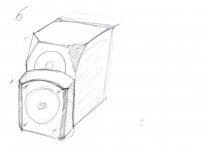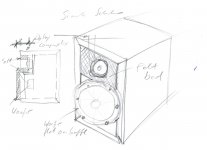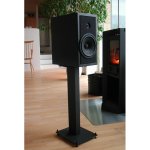Here is an example of an economical monitor i designed for Sonics :Sonics Argenta Test Lautsprecher
I solved the diffraction problem with offsetting the tweeter. Pro Ac has pioneered that i think. It works very well.
I solved the diffraction problem with offsetting the tweeter. Pro Ac has pioneered that i think. It works very well.
I did a lot of speakers with a flat baffle that sounded nice and by playing around with non textbook crossovers i got a rather flat response with good radiation pattern. If that is the wish, i can do that fast and easy. Then we have an entry level design that can be build by virtually everyone that doe snot have two left thumbs.
Yes, please go beyond that!
Regards
/Göran
This guy makes a case that a phase linear and slim speaker images better. He can not answer the whys and hows convincingly i think :Loudspeaker Imaging Theorem
He also thinks that series crossover image better.
He also thinks that series crossover image better.
Here is the famous LC Audio circuit :L C Audio Technology / Series Filter
I did some research on series filters too but could not find a simple one that met my lobing criteria. Usually the tweeter ends up with a shelf in the lower reaches that makes phase matching to the woofer difficult. The series filters that behaved well in this regard ended up with even more components then a comparable parallel filter. I have not totally given up though.
This guy makes a case that a phase linear and slim speaker images better. He can not answer the whys and hows convincingly i think :Loudspeaker Imaging Theorem
He also thinks that series crossover image better.
I wish it was simple as that, but in my experience there is so many factors to consider when creating a loudspeaker, so to say that that a slim speaker alone image better is to me nonsense. With a too narrow baffle you could as an example have internal side-wall reflection issues and the diffraction issues can be horrible, if not designed properly.
I've used off-set tweeters allot before, but found out that placing them correct on the center line with adequate baffle width and optimizing them from the 15deg off-axis measurements generally simplifies the design and make them sound better.
Regards
/Göran
Last edited:
Here is the famous LC Audio circuit :L C Audio Technology / Series Filter
I think Troel has written something about them.
crossovers
Series cross-over can be good in certain designs, but usually I think they doesn't cut it and I gave them up years ago.
Ooops now I might have offended someone religious!
Regards
/Göran
I have more or less the same experience, universally they can not be used at all and i feel more comfortable with parallel networks. OK, lets do the speaker symmetrical.
Here is another idea for a cabinet.
Yes, this one looks feasible, but I don't think you need the bevel on the tweeter baffle. Do the same round-over as on the mid-woofer.
This is an example of an off-set that really works without major issues:
The QM60 | Guru Loudspeakers
They guy (Ingvar Öhman) who made this loudspeaker is one of the worlds best designers and I challenge anyone to discuss loudspeaker designs with him. He's simply a natural born genius!
Regards
/Göran
Yes, i know this speakers and heard them on shows. He gave an interview that i found fascinating. I also like the no nonsense styling. The only problem i have is the sharp edge between the woofer and the tweeter. I made experiments with this and got in trouble. He uses a small waveguide though.
How thick is the mid-woofer baffle? My guess is that you need something between 25-30mm?
If so it's better to have the baffle straight at the top to get the center to center distance between the tweeter and mid-woofer as small as possible. If any diffraction causes an issue, use some foam at selected places (NHT style), to diffuse it.
Regards
/Göran
If so it's better to have the baffle straight at the top to get the center to center distance between the tweeter and mid-woofer as small as possible. If any diffraction causes an issue, use some foam at selected places (NHT style), to diffuse it.
Regards
/Göran
Here is another idea. sorry to say that i did not invent that ether.
It is a danish design.
On the other hand i am not a big fan of heavy felt damping. It can be an advantage on axis but you loose energy off axis.
I think i go for a Guru Clone. Nice word that is
It is a danish design.
On the other hand i am not a big fan of heavy felt damping. It can be an advantage on axis but you loose energy off axis.
I think i go for a Guru Clone. Nice word that is
Attachments
Here is another idea. sorry to say that i did not invent that ether.
It is a danish design.
On the other hand i am not a big fan of heavy felt damping. It can be an advantage on axis but you loose energy off axis.
I think i go for a Guru Clone. Nice word that is
If I was you I would go for the Guru clone.
The loudspeaker in the picture would have some tweeter diffraction isues and doesn't have the right amount of time delay that you require.
I would also use an baffle with of at least 25cm, but that depends on how the mid-woofer measures. This would give an baffle diffraction centered at around 500Hz depending on baffle round-over.
Also I would design the loudspeaker to have the tweeter at ear height or below in order to reduce the baffle diffraction issues.
This could be a great speaker!
Regards
/Göran
I think i will mix the Guru Clone with some other little ideas.
It is simple to make, looks good and will do the job just fine.
There are many ways to measure the acoustic center.
One very simple way is to measure the raw response of the drivers with the same time of flight ( on the same baffle of reference, the basket depth difference has to be taken into account too), put that into the simulator, reverse the tweeter and tweak the delay until they cancel most. The other way is to measure the transfer function, do a Hilbert transform,
calculate the excess phase and tweak excess delay until it is flat. That way you have cancelled the amplitude response out of the picture.
It is simple to make, looks good and will do the job just fine.
There are many ways to measure the acoustic center.
One very simple way is to measure the raw response of the drivers with the same time of flight ( on the same baffle of reference, the basket depth difference has to be taken into account too), put that into the simulator, reverse the tweeter and tweak the delay until they cancel most. The other way is to measure the transfer function, do a Hilbert transform,
calculate the excess phase and tweak excess delay until it is flat. That way you have cancelled the amplitude response out of the picture.
Last edited:
I think it is also a good idea to make the speaker somewhat wider then the typical monitor. That is a really good Guru idea. Gives the tweeter better support in its lower reaches and makes the baffle step not that drastic. Yes, i will place the tweeter on ear level and put the acoustic center in the middle of the tweeter membrane. That needs some more delay compensation though then putting the acoustic center between tweeter and woofer. From the geometry putting the acoustic axis on the tweeter it is even closer to the microphone. In the far field ( say at 1m distance or more ) the diffence will be small though.
joachim,
i will follow this with interest, i do have satori midwoofer and scanspeak HDS tweeter on hand. i was planning to do OB, but it seems i wont have enough space for them.
So im thinking to follow your enclosure design, and modified passive xover or ACTIVE with MINIDSP using HDS.
what would be your opinion on this?
regards
henry
i will follow this with interest, i do have satori midwoofer and scanspeak HDS tweeter on hand. i was planning to do OB, but it seems i wont have enough space for them.
So im thinking to follow your enclosure design, and modified passive xover or ACTIVE with MINIDSP using HDS.
what would be your opinion on this?
regards
henry
Last edited:
- Home
- Vendor's Bazaar
- SB Acoustics Satori Monitor


